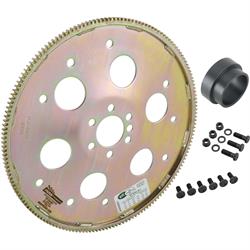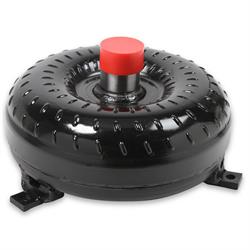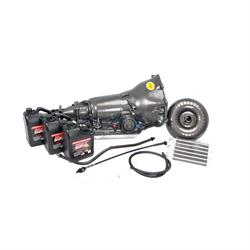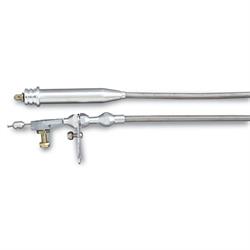700R4 Transmission Complete Guide | Diagrams, HP Ratings, FAQ
GM's 700R4 Transmission Specs & Weight
What is a 700R4 transmission? GM’s venerable overdrive automatic was introduced in 1982 and has been bravely serving ever since in everything from trucks and utility vans to Caprice police cars, Corvettes, and Camaros, not to mention about a zillion street rods and classics that have had one swapped in.
In the modern age of transmissions with a zillion forward gears, it’s not unreasonable to wonder how many gears does a 700R4 have? The correct answer is four forward gears, and in the 80’s, just the addition of that overdriven fourth was pretty revolutionary. These transmission were, and still are, a great way to add an overdrive to increase the efficiency of a thirsty V8.
In the forty-some years since its debut, we’ve learned a lot about these transmissions, both good and bad. Here’s a quick overview of the trusty old 4-speed.
GM 700R4 Specs:
- Production Years: 1982–1993
- 700R4 Weight (Dry): 155 lbs. (Wet): 170–175 lbs. (with ATF)
- Transmission Type: 4-speed automatic with overdrive
- Overdrive Ratio (4th Gear): 0.70:1
- Input Shaft Spline Count: 27 splines (early models), 30 splines (1984+ models)
- Output Shaft Spline Count: Most typically 27-spline; 700R4 yoke is shared by TH350, Powerglide, and many manuals.
- Case Material: Cast aluminum
- Bellhousing: Integrated (one-piece case design)
- Pan Shape: "Square with a corner missing" with 16 bolts
Common Applications
- GM trucks (C/K series, S-10, Blazer)
- Camaro, Firebird
- Corvette
- Caprice, Impala, and other full-size GM cars
700R4 Gear Ratios
The real advantage of a 700R4 over alternatives like the TH350 or TH400 is the added versatility offered by the overdriven 4th gear. 700R4s also have deeper 1st gears than their 3-speed cousins. Here’s what that looks like:
- 1st Gear: 3.06:1 - Great for off-the-line acceleration. This low ratio makes for strong pulling power, useful for towing, off-roading, or quick launches.
- 2nd Gear: 1.62:1 - Keeps the power coming as you move through the mid-range. It helps maintain momentum without a big drop in engine speed after 1st gear.
- 3rd Gear: 1.00:1 (Direct Drive) - A straight 1-to-1 ratio. At this point, the engine and driveshaft are turning at the same speed. This is the gear older 3-speed automatics would usually top out in.
- 4th Gear (Overdrive): 0.70:1 - This gear lowers engine RPM by about 30 percent compared to 3rd. It's designed for cruising at highway speeds, improving fuel economy and reducing engine wear and noise.
- Reverse Gear: 2.29:1 - A moderate reverse ratio that provides sufficient torque for backing up trailers or maneuvering on inclines without putting too much strain on the drivetrain.
700R4 Transmission Length
In spite of an extra set of gears, the 700R4 is dimensionally similar to the TH350. We’ve found that they typically fit in place of 3-speeds without cutting tunnels or other significant modification. A swap will however typically require a different length driveshaft. The 700R4 length was different depending on the original application. The standard version, found in most GM cars and trucks, measures about 30.75 inches from the bellhousing to the end of the tailshaft. The Corvette version is shorter, measuring around 28.875 inches.
If you don’t have a tape measure handy, you can check the casting numbers on the tailshaft housing to determine which one you’re working with. Standard units usually have numbers like 14073723 or 8679037, while the Corvette tail housing has 8630084. There are also different main case casting numbers depending on the year. While other numbers are out there, it’s common for early models (1982–1984) to have casting number 8663549, mid-years (1984–1986) to have 8652879, and the stronger late models (1987–1992) to be marked 8676359.
Is The 700R4 a Good Transmission?
Absolutely. The 700R4 is a great transmission as long as it’s used responsibly and adjusted properly. In stock form, the 700R4 is ideal for light-duty use in daily drivers and weekend cruisers. For serious performance, it can be upgraded to handle 500 to 600+ horsepower with stronger internals, a shift kit, improved cooling, and a performance torque converter. More on this later.
How Much Horsepower Can a 700R4 Take?
A stock “500hp 700R4” doesn’t exist. By and large, factory 700R4 transmissions were bolted up to 200 hp small blocks, so asking a stock 700R4 to hang in there behind a 500+ horse engine is a recipe for disaster. A stock 700R4 horsepower rating is usually somewhere around 300-350 horsepower, depending on the rest of the combination and how it’s treated. What year is the best 700R4 transmission? Early units (’82-’87) are best avoided if possible. As we alluded to above, it’s generally accepted that the later transmissions (’87-’92) are the best, strongest units.
The 700R4 hp rating for upgraded units can reliably be 500-600 horsepower if they’re done right. Depending on what you’re trying to do (drag race, towing, etc.) there’s plenty of upgraded hardware on the market. How much does it cost to rebuild a 700R4? Like most any upgrade to your car, the more trick stuff you throw into the case can greatly affect the price tag. Here are some common improvements:
- Upgraded pump – An aftermarket 700R4 transmission pump is typically a bolt-in replacement for the factory pump and may feature trick improvements over the stock pump like billet rotors.
- Valve body - Replacement 700R4 valve bodies can not only change the interface between the driver and the transmission by reversing the 700R4 shift pattern and adding fully manual control, they can also change the dynamics of the transmission by allowing higher line pressures.
- Aftermarket torque converter – A well-chosen torque converter for a 700R4 will play a huge role in making your car work the way it’s supposed to and handle the power that you’re putting down.
- Deep transmission cooling pan – A deep 700R4 pan will add fluid capacity as well as extra cooling capability, perfect for transmissions that are working hard racing or pulling.
- Heavy-duty clutch packs – In particular, upgrading the troublesome 3-4 clutches.
- Hardened input and output shafts – Extreme applications will require more stout parts than even the factory-upgraded ’84-up pieces.
- External cooler – Not unlike your engine, heat is one of your transmission’s primary enemies. Just as you won’t cheap out on your radiator, a well-chosen and properly positioned transmission oil cooler will help your transmission live through abuse like racing and towing.
- Shifter- The shifter is your connection to the transmission. A quality 700R4 Shifter with positive detents can prevent accidentally damaging the transmission by engaging the wrong gear.
700R4 Problems | What is The Weakness of the 700R4?
The elephant in the room with 700R4s is the throttle valve (or TV) cable. Many a 700R4 has died prematurely due to an improperly adjusted TV cable. Essentially, the TV cable attaches to the carburetor or throttle body linkage and relays throttle input to the throttle valve in the transmission, thereby letting the transmission know what the engine is doing so it can respond accordingly. When the throttle is mashed wide open, the TV cable is pulled and tells the transmission that it needs to max out line pressures to clamp down bands and clutches and raise the shift points. Conversely, casual acceleration will be relayed to the throttle valve and the lower line pressure will allow for smooth shifts at a sensible RPM.
Problems occur when the cable is incorrectly adjusted, essentially causing the engine and transmission to be out of sync. Too far one way and the transmission will think that the engine is at WOT when it’s not, causing it to hammer into gear and shift way higher than it should. Misadjustment too far the other way means that when the engine is in fact being pushed hard at or near WOT, the transmission still thinks it’s out for a leisurely Sunday drive. In this scenario the line pressure in the transmission is too low, causing it to shift before it should and slip. It’s easy to see how either scenario can be hard on the transmission. In fact, extremely out of whack TV cables will burn up a 700R4 in relatively short order. Your author has spent time standing in the ditch next to a smoking Camaro while waiting for the tow truck due to this very error and does not recommend it.
The internet is full of tricks for adjusting a 700R4 TV cable. In our experience, the best way to do this is to drop the transmission pan and actually look at the interface between the arm that is pulled by the cable and the throttle valve. While small tweaks can be made in either direction, the generally preferred setup is for the valve to be completely (or almost completely) closed at idle, then completely open at wide open throttle. If you doubt your ability to properly make this adjustment, the local transmission shop likely has plenty of experience with these and will be able to help you out.
Beyond the TV cable issue, stock 700R4s have a few other weaknesses. They’ve been known to burn up the 3-4 clutch pack, especially when asked to tow or otherwise pull a heavy load. Early units used a 27-spline input shaft that became a known weakness and was replaced by a stronger 30-spline unit in 1984. Otherwise, it’s worth remembering that stock units are more than 30 years old at this point and those that haven’t been rebuilt will likely be in need of some love. Automatic transmissions are complicated, so in lieu of learning how to rebuild a 700R4 transmission and following a complicated 700R4 rebuild procedure, it may be worth hitting up the local transmission shop to help with your rebuild or consider buying a new 700R4 transmission that has already had all the dirty work done.
If you’re at the swap meet looking at a used 700R4, there are a few things to check. Look for the internal tab for the TV cable and make sure it’s functioning properly. You might be able to check it from the top, but it will be easy to see with the pan off. While the pan is off, check the condition of the fluid. As with any automatic, this is the best indicator of the transmission’s condition. Dark fluid that smells burnt (if you’ve never smelled this before, don’t worry, you’ll know it when you encounter it) is an almost certain sign that things are amiss and the transmission will need a rebuild. Also check for anything obvious like cracks in the case or tailshaft housing. In particular, take a close look at the bellhousing. Driveline vibrations and hard use can cause cracks in this area. Also be mindful of what transmission you’re actually looking at. Casting numbers will help indicate an early or late transmission and the tailshaft housing length will tell you what the original application was and whether or not it’s the right length to fit in your car.
What Type Transmission Fluid For 700R4?
Stock or high-mileage 700R4 transmissions will almost always use Dexron III ATF. Dexron VI can be used in rebuilt or upgraded transmissions that are sealed up well enough to handle the extra slippery silicone fluid. How much fluid should you add to a 700R4? As with any automatic, it’s going to vary based on factors like the pan, converter, and cooler. As a general rule, a 700R4 will take approximately 11 quarts if you’re filling a dry transmission and need to fill the converter as well. After a pan drop fluid and filter change, you’ll typically add about 5 quarts. The best rule of thumb for any automatic is to check the fluid level on the 700R4 dipstick with the engine running in park and everything fully up to temperature.
Can You Run a 700R4 Without a Computer?
Does a 700R4 need a computer? Nope, the 700R4 is an entirely mechanical transmission. Shift points and firmness are determined by the TV cable and governor. This makes the 700R4 a great choice for those wanting an overdrive automatic without having to fuss with any computer nonsense.
The one small caveat here is the torque converter lockup. While not always the case with an aftermarket setup, factory 700R4s ran a lockup converter. Among other effects, a converter that locks at cruising speed reduces engine RPM, adding to the benefit of the taller gear, and reduces heat that would be caused by the converter slipping at sustained cruise RPM. On these stock setups, the engine’s computer ran the lockup, but there are aftermarket 700R4 Lock-Up Kits available for swaps into older cars that allow the lockup converter to function as it should on a carbureted engine where no computer is present.
We’ve been talking a lot about putting a 700R4 behind an old-school small block. You may be wondering will a 700R4 bolt up to a 454 or other big block or will a 700R4 bolt up to a 5.3 or other LS-based engine? The answer in both cases is yes. As long as they are built to handle the torque, a 700R4 will bolt right up to a big block Chevy as long as the proper 700R4 flexplate is used. Gen III and IV LS engines are a bit trickier, but still possible with a 5.3 to 700R4 adapter. In fact, the dished flexplate and torque converter spacer used here will work with just about all LS engines, allowing you to keep your 700R4 when you LS-swap your car. Just keep in mind that you’ll need to figure out how to actuate the TV cable from the throttle linkage.
What Year Did GM Switch From 700R4 to 4L60E?
The 4L60E debuted in 1993 as an electronically controlled evolution of the 700R4. Technically, GM had rebranded the 700R4 as a 4L60 in 1990 without making any changes to the transmission itself. That updated convention breaks down like this: 4(4-speed), L(longitudinal drivetrain, ie rear or four-wheel drive), and 60 as an indicator of torque handling or approximate max GVW for cars and trucks so equipped. The “E” designation added in ’93 indicated the addition of the electronic control that replaced the TV cable and instead relied on the computer to indicate engine load and RPM. For more details on GM automatics through the years, check out our guide on How to Identify GM Transmissions.
Automatic overdrive transmissions have come a long way in the last 40 years, but the 700R4 is still a strong and reliable choice for your hot rod. Take care to avoid the common mistakes, upgrade with the right 700R4 transmission parts, and maintain it properly and you will be rewarded with years of trouble free miles. All while knocking down better fuel mileage than that old three speed auto is capable of delivering.







